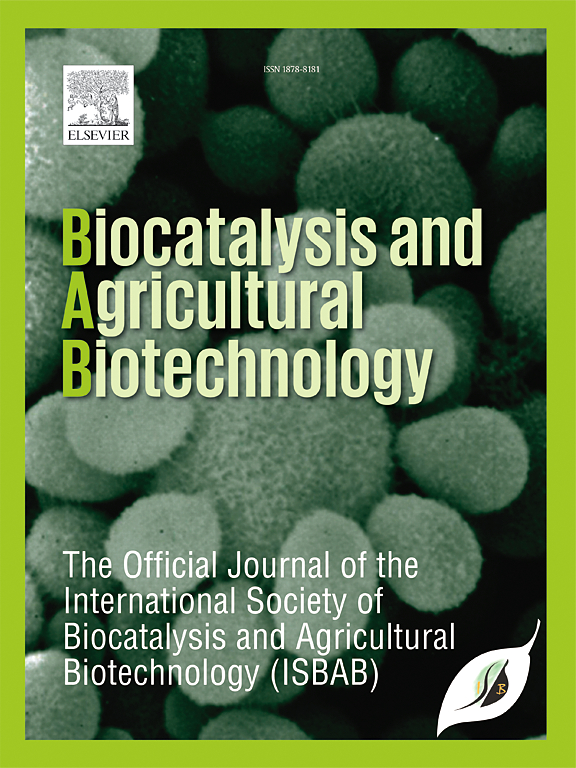Chemical and nutraceutical characterization of coproducts obtained during the protein concentrate preparation from azufrado common (Phaseolus vulgaris) bean grains
IF 3.8
Q2 BIOTECHNOLOGY & APPLIED MICROBIOLOGY
引用次数: 0
Abstract
Common beans are recognized as an alternative source of protein, and valorizing their coproducts aligns with the 2030 Agenda for Sustainable Development Goals. This study aimed to evaluate the nutritional and phytochemical properties of three coproducts generated during production of Azufrado Higuera common bean protein concentrates: grinding coproduct (GCP), alkaline extraction coproduct (AECP), and isoelectric precipitation coproduct (IPCP).
The coproducts were obtained from the grinding step, alkaline extraction residue, and supernatant from isoelectric precipitation. Their composition, including starch, protein, dietary fiber, minerals and bioactive compounds (phenolics, flavonoids, tartaric esters, and condensed tannins), as well as antioxidant activity were analyzed. Starch was predominant in AECP (61.61 g/100 g dry matter [DM]), followed by GCP (21.25 g/100 g DM) and IPCP (1.99 g/100 g DM). Crude protein was highest in IPCP (36.07 g/100 g DM), followed by GCP (28.17 g/100 g DM) and AECP (6.12 g/100 g DM). Total dietary fiber was most abundant in GCP (39.22 g/100 g of DM). Mineral analysis shows similar calcium and iron content across all coproducts, with IPCP exhibited magnesium and zinc content. Regarding bioactive compounds, IPCP demonstrated the highest phenolic compounds content and antioxidant capacity, while GCP was richer in flavonoids, flavonols, tartaric steres and condensed tannins. In conclusion, the nutritional and phytochemical properties of these coproducts derived from the bean processing industry highlight their significant potential as ingredients for functional food formulation. Furthermore, their utilization offers a promising pathway for reducing waste, minimizing environmental impact, and enhancing the sustainability of the bean processing industry.

紫豆(Phaseolus vulgaris)豆粒蛋白浓缩制备副产物的化学和营养特性
普通豆类被公认为蛋白质的替代来源,对其副产品进行估价符合《2030年可持续发展目标议程》。本研究旨在评价阿祖拉多黑豆浓缩蛋白生产过程中产生的3种副产物:研磨副产物(GCP)、碱萃取副产物(AECP)和等电沉淀副产物(IPCP)的营养和植物化学性质。副产物由磨矿、碱提渣和等电沉淀法上清得到。分析了它们的组成,包括淀粉、蛋白质、膳食纤维、矿物质和生物活性化合物(酚类物质、类黄酮、酒石酸酯和缩合单宁),以及抗氧化活性。淀粉在AECP中占主导地位(61.61 g/100 g干物质),其次是GCP (21.25 g/100 g DM)和IPCP (1.99 g/100 g DM)。粗蛋白质最高的是IPCP (36.07 g/100 g DM),其次是GCP (28.17 g/100 g DM)和AECP (6.12 g/100 g DM)。总膳食纤维在GCP中含量最高(39.22 g/100 g DM)。矿物分析表明,所有副产物的钙和铁含量相似,IPCP显示镁和锌含量。在生物活性成分方面,IPCP的酚类化合物含量和抗氧化能力最高,而GCP则含有较多的黄酮类、黄酮醇类、酒石酸体和缩合单宁。综上所述,这些来自豆类加工业的副产品的营养和植物化学特性凸显了它们作为功能性食品配方成分的巨大潜力。此外,它们的利用为减少浪费、最大限度地减少环境影响和提高豆类加工业的可持续性提供了一条有希望的途径。
本文章由计算机程序翻译,如有差异,请以英文原文为准。
求助全文
约1分钟内获得全文
求助全文
来源期刊

Biocatalysis and agricultural biotechnology
Agricultural and Biological Sciences-Agronomy and Crop Science
CiteScore
7.70
自引率
2.50%
发文量
308
审稿时长
48 days
期刊介绍:
Biocatalysis and Agricultural Biotechnology is the official journal of the International Society of Biocatalysis and Agricultural Biotechnology (ISBAB). The journal publishes high quality articles especially in the science and technology of biocatalysis, bioprocesses, agricultural biotechnology, biomedical biotechnology, and, if appropriate, from other related areas of biotechnology. The journal will publish peer-reviewed basic and applied research papers, authoritative reviews, and feature articles. The scope of the journal encompasses the research, industrial, and commercial aspects of biotechnology, including the areas of: biocatalysis; bioprocesses; food and agriculture; genetic engineering; molecular biology; healthcare and pharmaceuticals; biofuels; genomics; nanotechnology; environment and biodiversity; and bioremediation.
 求助内容:
求助内容: 应助结果提醒方式:
应助结果提醒方式:


